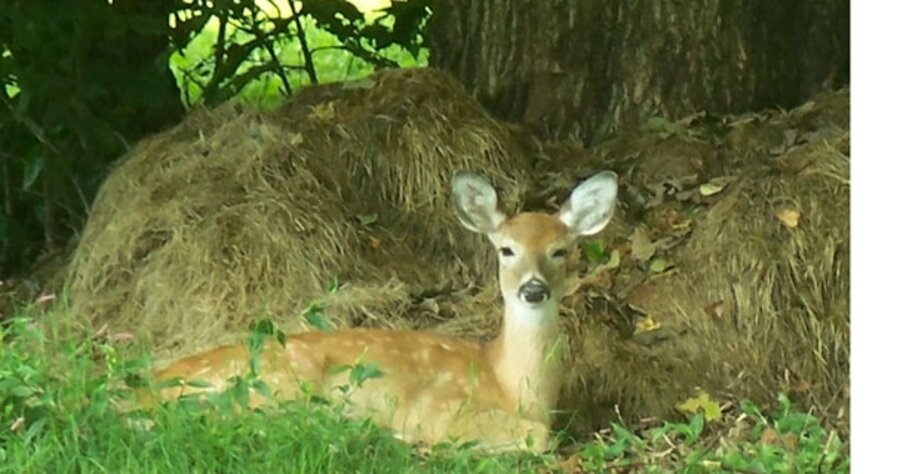Mounds of mulch, and know-it-alls
Loading...
The subject line of an e-mail I received said "Bambi," which clued me in that a deer was going to be involved. So I wasn't surprised to open a cute photo of a young deer resting under a suburban tree. But what caught my attention next -- and kept it -- was the huge pile of mulch behind the small animal.
Ah, yes, mulch mounds strike again. No matter how loudly horticulturists rant against those piles of grass clippings, wood chips, and other organic materials dumped right up against tree trunks, people keep doing it.
And I'm going to add another voice against the practice -- although I didn't to the person who sent the e-mail. (More on that in a minute.)
Scott Aker of The Washington Post calls them "mulch volcanoes," and says that if he could eliminate one misguided garden practice, that would be it.
OK, you may be saying, but I thought mulch was good for trees. And you're right. It keeps string trimmers and other lawn equipment at a healthy distance so the trunk isn't damaged (letting in insects and diseases).
And mulch keeps moisture in the soil -- although the roots of a tree range much, much wider than the tiny area right up against the trunk.
So the problem isn't the mulch itself, it's how it's applied -- the mounding and also placing it right up against the trunk.
Deb Lambert points out that a too-heavy mulch can prevent oxygen from getting to a tree's surface roots and can keep those roots constantly wet (as if you'd overwatered -- and you know the results of that).
But the mounding part is also problematic. This PDF you can download from Rutgers explains that too-thick mulch around trees can become home to insects, diseases, and chewing rodents. It can also change the pH of the soil. And -- this is especially true for large quantities of grass -- it can heat up just as a compost pile does and harm young trees or prevent older ones from going dormant in a timely manner in fall.
By the way, I always recommend letting fresh grass clippings dry for a few days before spreading them around any plants to avoid heat damage.
So, what's the right way to mulch trees?
First, use no more than three inches of mulch (it's OK to start with four or five inches of mulches of very loose materials such as pine needles, which are going to pack down within a day or two, but stick with two or three inches of bark and other mulches that don't compact).
If drainage is poor, use only two inches of mulch around your trees.
Another tip: Always shred leaves that you use as mulch. Otherwise, they become an impenetrable wet mass.
Finally, don't let the mulch touch the tree trunk. Keep it three or four inches away. There's a good photo here that shows you the right and wrong ways. Mulch wide instead of deep. (Did you know that a tree's roots extend beyond the ends of the branches? Although you don't want that much mulch -- it would call attention to itself.)
OK, now that we've settled that, why didn't I say something about the mulch piles to the person who sent the cute deer photo? Because I'm trying -- not always successfully -- not to be a know-it-all.
This was brought home to me earlier in the week when a couple who bought a row house in the neighborhood tore out all the plants in the tiny front plot and spent an entire day replacing them -- with all the wrong things.
This is going to sound silly to some of you -- and others will understand -- but I simply couldn't look at it as I walked back and forth by it each day. I wanted to say, "Look, if you'd gotten some professional advice -- other than at a nursery where they hadn't seen your garden and didn't know that it's completely filled with thirsty roots from the Japanese zelkova street trees, you'd have gotten something else. And you wouldn't have planted that weeping evergreen right up against the fence, so it will poke out into the sidewalk within 18 months."
But it was none of my business. They hadn't asked for my advice. They were very pleased with what they'd done. And so I bit my tongue and smiled. (I haven't gotten good enough at this to be able to say, "How nice.")
So I kept my mouth shut about the mulch, too, although the picture stayed in my mind. Then my correspondent mentioned the mulch in another e-mail and so I said something. She was disturbed , though, that they'd been doing it wrong for many, many years.
Which goes to show that plants rarely read garden advice. Even if you do it wrong, sometimes you succeed -- even a few of those plants of the neighbors' will probably make it, if they're watered enough. But it's best to avoid problems in the first place.





